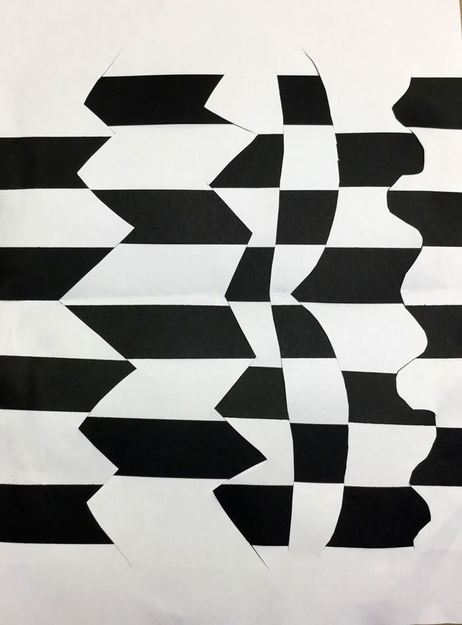|
This is a project based on the artist, Sol LeWitt. I did something similar last year. You can read the details here. This year, I just had students color it using markers instead of gluing down strips of paper.
0 Comments
2nd graders recently learned about the Op artist, Bridget Riley. Ms. Riley is an artist from London who specializes in creating optical illusions in her artwork. Her artwork is usually large-scale because it has a more disorientating effect on the viewer when it is larger. The kids thought her artwork was super cool! They were blown away by the fact that even though the painting wasn't moving, it gave the effect that it was. This Bridget Riley project was different than what I have done in the past. This is a project that I got from my friend, Tasha Newton, over at iartmyjob.wixsite.com !This year, I had students create a weaving inspired by her work.
On day one, I introduced students to her work. Then, they received a white sheet of paper that had been folded in half. They cut 5 crazy lines into it (curly, angled, etc). Then they began to weaving into these oddly cut shapes. The second day, they finished their weaving. Then they chose a black sheet of paper, folded it in half, and cut a geometric shape from it. They glued the black paper with the shape cut out of it on top of their weaving. One class was a day behind the others so they just created the weaving and didn't glue the black paper on top. 2nd Grade just finished up learning about Sol LeWitt. Sol was an American artist who passed away just a few years ago. He is known as a conceptual artist as well as a minimalist. Conceptual artists believed that even something as simple as coming up with the idea for an artwork could be considered art and minimalist created work as simply as possible. Sol is most well-known for his instructional wall drawings. He would write up directions for an artwork and then send the directions to a museum or gallery. It was up to the museum/gallery to create the artwork based on his instructions. Because the instructions were open to some interpretation, no two artworks came out the same, even with the same directions. He is also known for his simple shapes, lines, and colors. 2nd grade did a project somewhat similar to this last year with Bridget Riley using colored pencils. This year I put a different spin on it and focused on Sol LeWitt instead. After learning about Sol we had a conversation about complementary colors and where they were in relation to each other on the color wheel. Students were then given a 6x18 sheet of paper that I had folded into thirds. I also pre-cut tons and tons of half inch strips of construction paper. Each table was given a set of complementary colored strips and students were asked to fill up each 1/3 of their 6x18 paper with a different set of complementary colors. By the end of class, they had all three sets of complementary colors displayed across their 6x18. PLEASE NOTE THAT YOU NEED TO DO AN AWESOME JOB OF GLUING OR YOUR SHAPES WILL LOSE ALL THEIR PAPER STIRPS WHEN YOU CUT THEM OUT NEXT CLASS. On the second day of the project, we recapped on Sol LeWitt. Then we did the EXACT. SAME. THING. as we did last class. We glued 1/2 inch strips down onto another 6x18. On the final day of the project, we talked about Sol’s use of geometric shapes. Students used geometric shaped tracers to trace a shape onto each section of one of the 6x18 papers. Students then cut out their shape and glued it down to their remaining 6x18 paper, making sure that they gave their shape a quarter turn so that the shape’s lines were perpendicular to its background. When finished, students tweeted (their version of an exit ticket) what the three sets of complementary colors. Lastly, I found some instructions for a instructional drawing online so students were asked to make their own drawing by following the instructions. At the end of class, we toured our “art museum” and checked out how different everyone’s work was based on the same instructions. This also gave us a chance to talk about how you act in an art museum. Tip #1: Walk SLOWLY. Tip #2: Walk with your hands behind your back. Tip #3: Mutter “That’s interesting” in front of an intriguing artwork. |
Devon CalvertHarmony and Consolidated Elementary Art Teacher in Milton, WI. UW-Eau Claire graduate. WAEA President. Apple Teacher. Archives
March 2019
Categories
All
|















 RSS Feed
RSS Feed
